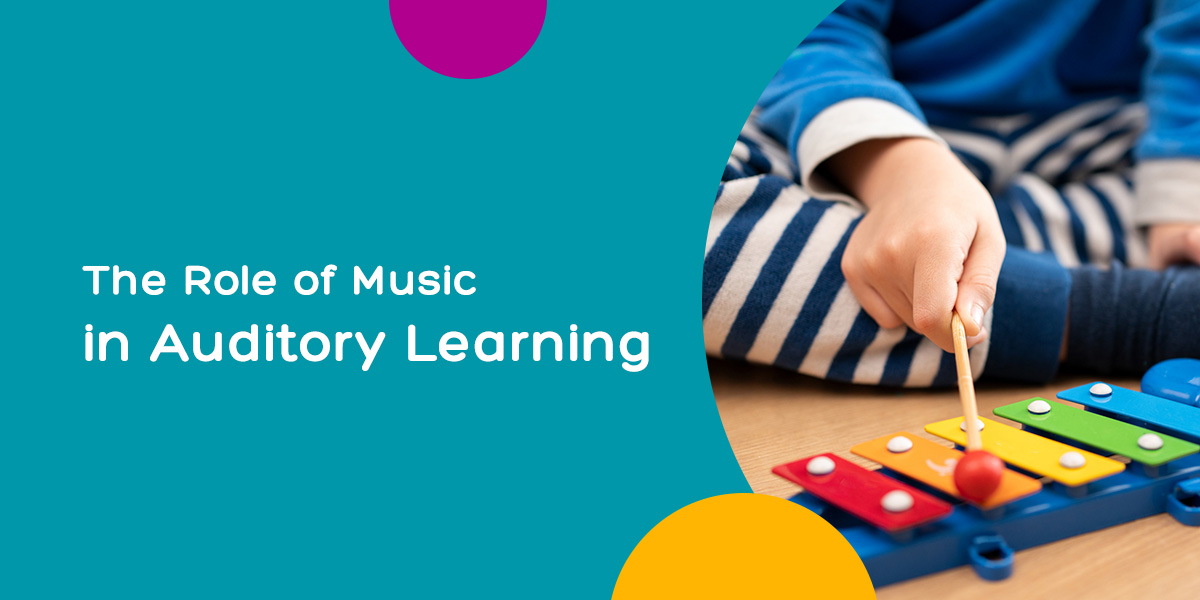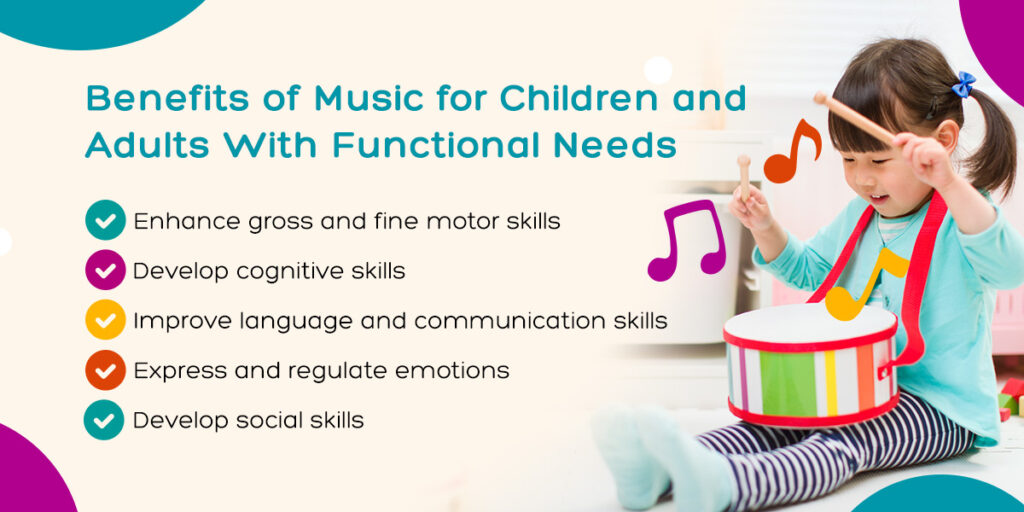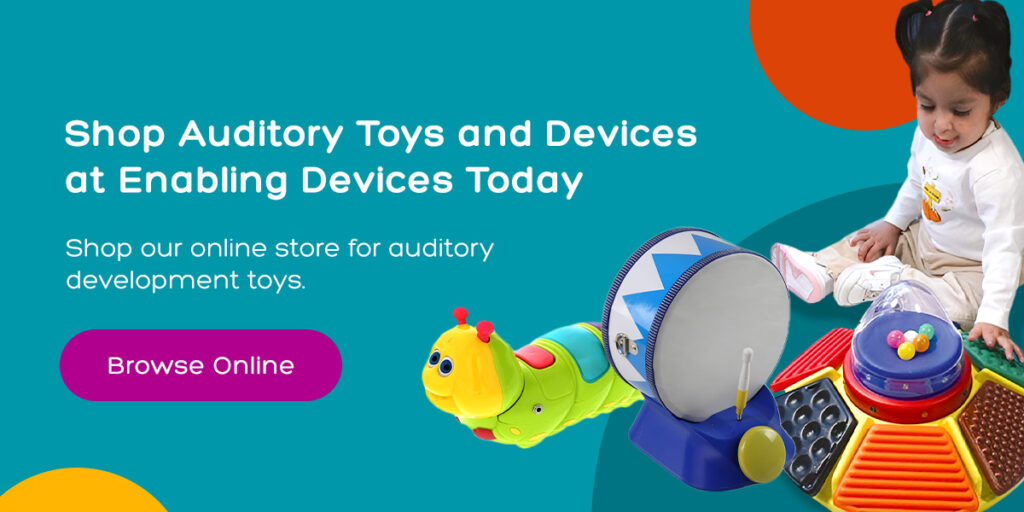Auditory development is the ability to identify speeches and sounds within continuous sound input. This development starts at birth and is refined throughout childhood. Spoken language — both using and understanding words — grows out of this experience.
Auditory learning is critical, especially for children and adults with functional needs (commonly referred to as special needs). Individuals with conditions like Auditory Processing Disorder (APD), hearing dyslexia and hearing impairment often have difficulties recognizing and interpreting sounds.
Music is a tool that parents and teachers can use to encourage auditory learning for people of all actual and developmental ages. Auditory music toys, tools and activities can help users recognize and understand sounds as well as carry these skills into other areas of their lives.
Understanding Auditory Learning Disabilities
APD impacts a person’s ability to process and understand sounds. They may be able to hear a sound but have trouble understanding or identifying it. APD can cause challenges with:
- Processing sounds: Those with APD may have limited phonemic awareness that makes it difficult to process sounds.
- Social and emotional experiences: Since individuals with APD have difficulty understanding others, they may experience feelings of isolation or anxiety in social situations. They may feel embarrassed when talking with others and not want to participate in group activities. These experiences can impact their sense of self-worth and self-esteem.
- Attention and focus: Since it takes more effort for people with APD to process auditory information, they can feel mentally exhausted. This can create challenges with paying attention and staying engaged, especially during verbal activities.
- Reading and writing: Children and adults with APD can find it challenging to recognize sounds in words, so they have difficulties recognizing and understanding words. This can lead to reading fluency and comprehension challenges.
Neuroplasticity — the brain’s ability to change in response to stimuli — is the key when it comes to APD. For example, since a child’s brain is still developing, auditory learning helps them learn how to process sounds and language. As a result, music is one of the most effective ways to develop auditory processing skills for children with functional needs.
How Auditory Music Learning Works
Music is an effective tool for improving cognitive, physical and auditory skill development. Many elements of music directly connect to development — for example, singing can improve speech, and rhythm develops fine and gross motor skills.
Listening to music can help children and adults with APD do the following:
- Identify patterns: Music encourages the brain to look for patterns. Songs have different tones and speeds and play multiple sounds at once. Children and adults can process these sounds to identify the melody.
- Sort layered sounds: Listening to music helps individuals sort meaningful musical sounds from other sounds, like background noise. This skill can help students develop music appreciation and process language.
- Improve memory: Music changes the physical structure of a child’s brain by strengthening the connections between hemispheres. This development improves memory and executive function.
- Enhance attention and focus: Music strengthens the connection between the brain’s auditory and language centers. This ability helps children filter out auditory distractions like background noise, so they can direct their attention and focus on what matters.
Benefits of Music for Children and Adults With Functional Needs
Integrating music into your child or student’s routine can help them understand and recognize sounds in the world around them. As their brains learn how to process noise by listening to music, a neural framework is created, supporting growth and development in other areas.
Music can help individuals with auditory processing needs:
- Enhance gross and fine motor skills: Playing instruments, tapping out a rhythm and moving with the music improves motor coordination and motor skill development.
- Develop cognitive skills: Music stimulates various areas of the brain, improving problem-solving, attention and memory skills. These cognitive skills can help individuals learn and think critically about the world around them.
- Improve language and communication skills: Music stimulates neural connections in the brain that lay the foundation for language development.
- Express and regulate emotions: Some people with functional needs have difficulty verbally expressing their emotions. Music is a way for children and adults to express their feelings without talking to support their overall emotional well-being.
- Develop social skills: Group music sessions encourage students to communicate, interact and work together. These activities provide opportunities to practice listening to others, cooperating and sharing their thoughts with their classmates or teacher.
Strategies for Incorporating Music Therapy at School and Home
Music therapy uses music to achieve a goal. For children and adults with functional needs, music therapy can help them acquire and develop auditory processing skills. The following are some strategies for encouraging auditory learning through music:
- Adaptive instruments: Adaptive music instruments are designed so individuals with functional needs can play them in a way suited to their abilities.
- Multisensory activities: Make music therapy a multisensory experience by combining visual, kinesthetic and auditory learning. This approach reinforces auditory skills, enhances comprehension and keeps students engaged.
- Visual cues: Use visual aids like pictures or diagrams to cue your students. This visual support in music therapy can help individuals comprehend what they are learning and be more independent.
- Tailored activities: When considering how to bring music therapy into your classroom or home, think about your student or family member’s abilities and tailor the activity to suit their unique needs and interests.
Products and Toys That Enhance Auditory Learning
Enabling Devices has a wide range of toys for auditory development. These toys use music and sound to encourage exploration and play during music therapy sessions. Many of our toys are activated with an adaptive switch, so users of all actual and development ages can play.
Our selection of auditory development toys includes:
- Musical instruments: Our musical instruments are adaptive, so anyone of any ability can play and make music. Tap out a beat on a Drum, play notes on a Musical Snail or get a band together with the Adapted Music Kit.
- Music boxes and speakers: Play recorded tunes to improve listening skills and teach music appreciation. The Music Box plays four tunes and flashes lights. Activated through an external capability switch, our Music Master plays notes to make a unique song.
- Switch-adapted stuffed animals: We have many adorable stuffed animals that talk, sing songs or dance via an external switch. These toys improve auditory attention and development. Dance along with Let Loose Lenny or make Tabby Kitten meow.
Shop Auditory Toys and Devices at Enabling Devices Today
Enabling Devices has auditory learning toys, products and assistive technology to help children and adults with APD identify and understand sounds. We are passionate about helping individuals with functional needs live fulfilling lives by sparking joy and unlocking potential.
Shop our online store for auditory development toys. Learn more about auditory music learning by reading our blog or contacting our team today.
Linked Sources
- https://enablingdevices.com/product-tag/teaching-music-appreciation/
- https://enablingdevices.com/product-tag/increasing-focus-and-attention/
- https://enablingdevices.com/product-tag/developing-fine-motor-skills/
- https://enablingdevices.com/product-tag/developing-cognitive-skills/
- https://enablingdevices.com/product-tag/increasing-listening-skills/
- https://enablingdevices.com/product-tag/providing-independence/
- https://enablingdevices.com/product-tag/increasing-auditory-development/
- https://enablingdevices.com/product-category/switches/
- https://enablingdevices.com/product/drum/
- https://enablingdevices.com/product/musical-snail/
- https://enablingdevices.com/product/adapted-music-kit/
- https://enablingdevices.com/product/music-master/
- https://enablingdevices.com/product/music-box/
- https://enablingdevices.com/product/let-loose-lenny/
- https://enablingdevices.com/product/tabby-kitten/
- https://enablingdevices.com/shop/
- https://enablingdevices.com/blog/
- https://enablingdevices.com/contact/




